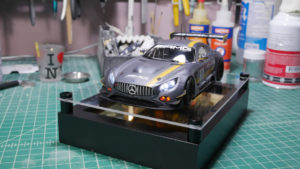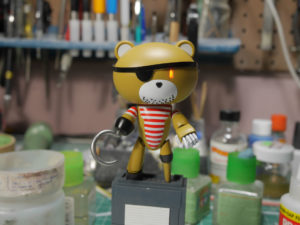This week’s update finally gets some real painting for the Sazabi. The main body parts are got some primer and the base coat. And I actually finished one of the parts for the damn thing, the fuel tanks, complete with decals and final clear coats!
More details after the jump.
Before any paint can be sprayed, the parts must be cleaned. After all the sanding, cutting, and other building processes, I took the parts and basically washed them with an ultra sonic cleaner. Getting ready for some paint. I have found that during the building process; dust, oils from my fingers,fine plastic particles and a whole list of other random things have made their way onto the surface of the plastic. If I just took a can of duster gas and sprayed the parts removing a good number of the less clingy particles, there would still be oils and other things that are more sticky, not so easily removed by a puff of air. So into the ultrasonic cleaner they go, and with only water. The parts come out feeling clean. So they’re placed on some paper towels and left to dry.
While the parts are dried, I took some time to run some color tests. I have several different clear reds and several different metallic paints. Various combinations produce different tones. I want to match up with the color scheme for the Ver Ka, with the three tones of red, the salmon, red, and deep red. Plastic spoons come in very handy for these tests as there are curves and it is a much more akin to what the paint will look like than spraying it on spruce, flat plastic, or even just paper.
After several tests, a few different paint mixes, and several hours later; I reached the three tones I want.
With the parts dry, I grabbed the inner frames and made sub-assemblies of all the parts. I’ve found that painting this way is less laborious as I can get several pieces painted at once, and keep paint tones the same on adjacent parts. Primer is sprayed and a few issues with missed sanding spots, rough sanding spots, missed nubs, and just issues with the surface prep from the mods; these select parts were re-sanded and then primed again. Some more than twice, but the end result is the following.
With the fuel tanks primed, the little plastic cosmetic mod looks like it belongs there as opposed to just being slapped onto the area. There’s a panel line that runs along the original tank, so I used some dynamo tape lined up with the original panel lines and scribe in some new lines along the added plastic. I used a scriber and some hasegawa metal saws.
The main body of the fuel tanks were then painted with Mr Color Metal Black. This paint has some fairly larger metallic particles in comparison to alclad, but I like the effect. A few hours later with the metal black cured, the tanks were masked off leaving the plastic addition and the end cap. These areas were painted with Mr Color Super Metallic Titanium.
Another few hours go by and the end cap is masked off and Alclad Transparent Red is sprayed over the plastic add on part. After a few minutes of drying all the masking layers are removed and the little metallic minus molds are temporarily placed for a picture. Getting close, at least for one part.
And when I said close for one part, we come to that part’s twin. While removing the tape, I also ended up removing a little chip of the Metal Black paint. This could have happened for a number of reasons. There could have been dust on the part and the paint didn’t completely stick. The primer layer below is visible so at the very least, it’s not the bare plastic surface prep that was at fault. Regardless, this needs to be fixed. The quick solution of just dabbing a small amount of paint with a brush will leave this even more visible. Simply masking the area off and just spraying isn’t a solution as the part is actually chipped and spraying paint over the area will show some crack lines around the chipped area.
So the proper way to fix this is to first mask off the areas painted in different colors. The plastic add on part is masked off with some parafilm and so is the end cap. The chipped area is then lightly sanded so the edges are blended into the surrounding areas. Then the part is repainted. Fixed without visible evidence there was ever a paint chip.
Things like this always happen. Knowing and accepting this fact of model building makes the occurance expected and much less frustrating when it does happen.
With the above area fixed, I was ready for the decals. Looking at the parts I felt that the titanium coloring was a little too light, and since the decals over that area are white, I wanted a more distinct tonal difference. So the whole tube was masked off again with parafilm and I sprayed alclad hot metal sepia over the end caps effectively darkening them.
After everything is cured, I decided to get the decals done. Against my usual practice of spraying a clear gloss first, I skipped it and applied the decals directly over the bare paint surfaces. It is refreshing that Bandai is providing water slide decals as part of the kit instead of the dry transfers.
The decals are cut form the sheet and dipped into water for a few seconds and then removed and placed onto a paper towel. The couple of seconds in the water is already enough water to soak into the paper backing and loosen the decal. Soaking the decal in the water for too long will completely dissolve the water slide’s glue and the water slide will have difficulty sticking to the surface of the part without help from a decal setting solution. Since I didn’t soak the decals too long, I can rely on the decal’s glue and not worry about using a setting solution.
A q-tip and water help move and place the decals in the correct position and location. Once in place, a small paper towel piece is pressed against the decal and the part squeezing out any excess water. The part is left to sit and set up.
The candy red section is sprayed with a gloss clear coat. Once this dried for a few hours, this was masked off and a clear flat is sprayed over the rest of the body. I wanted the main body of the fuel tank to be flat finished with the detail part glossy. The metal minus mold pieces are now glued into position using epoxy glue to avoid any crazing or frosting that may come with using CA glue. I also like to avoid using styrene cement here as the uncontrolled melting may ruin the paint finish if I wasn’t careful enough.
So of all the parts, I can at least say that I’ve gotten the fuel tanks completed.
Back to the main armor parts here is a close up look at the main torso and head primed. All the mods should look seamless. Satisfied, the parts are then and base coated with Mr White Base.
And for something completely random, at this month’s build gathering, a visitor to the BG’s host drove up in a Knight Industry’s Two Thousand (KITT) from the 80’s tv show Knight Rider. Pretty damn cool, the guy is part of a car club that mods cars into film and tv iconic vehicles. It was shown at Comic Con 2012 at the Mattel booth. Kinda cool.
I worked on the Saz’s gun at the build gathering. Since I’m not done with that yet, I’ll wait until it is completed and then have a blog post that details the start to finish work. It’s tough not posting everything I’ve done to date; but I do understand that there’s a certain disconnect and scatter brained feel to posts that show bits and pieces of part updates and there’s a lack of continuity. So hopefully, the next post will show the work on the Saz’s long rifle.





























how did you apply the clear to get a gloss and even color?
Yep. I sprayed several layers of gloss to get that tone.